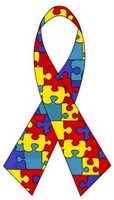Autism prevalence
 Whenever something is published about autism prevalence my email box overflows with notes from parents and colleagues about the 'latest study.' I couldn't even escape the prevalence question when we did the television spot on AM Buffalo: of course someone called in with this question. People always want to know why there are more diagnosed cases.
Whenever something is published about autism prevalence my email box overflows with notes from parents and colleagues about the 'latest study.' I couldn't even escape the prevalence question when we did the television spot on AM Buffalo: of course someone called in with this question. People always want to know why there are more diagnosed cases.The latest study is a new CDC prevalence study on autism that has been published in the May 5, 2006 issue of the “Morbidity and Mortality Weekly Report.” Results from the two surveys suggest that as of 2004, autism had been diagnosed in at least 300,000 children aged 4-17.
I have done a fair amount of reading on this topic and thought it would be interesting to share some of the other prevalence studies that have been recently published. They are listed below in 'References.'It is all as clear as mud, of course. Bottom line: there are more diagnosed cases of autism, some of them are geographically concentrated, and this is not the result of 'diagnosis shifting.'
The population may be aging, but the population is also having higher rates of autism. Occupational therapists need to stay up to date on the latest prevalence data and trends.
Happy reading...
References:
Centers for Disease Control and Prevention. (2000). Prevalence of Autism in Brick Township, New Jersey, 1998: Community Report, Washington, DC. [online] Executive summary available at: www.cdc.gov/ncbddd/dd/execsum.htm)
Changes in Population of Persons with Autism and PDD In California 1999-2002: An Update http://www.dds.cahwnet.gov/autism/pdf/AutismReport2003.pdf
Croen LA, et. al, (2002) The changing prevalence of autism in California. J Autism Dev Disord Jun;32(3):207-15 Abstract available at http://www.ncbi.nlm.nih.gov/entrez/query.fcgi?cmd=Retrieve&db=PubMed&list_uids=12108622&dopt=Abstract
Ehlers, S. & Gillberg, C. (1993) The epidemiology of Asperger syndrome: a total population study. Journal of Child Psychology and Psychiatry, 34 (8), 1327-1350. Available at http://www.maapservices.org/MAAP_Sub_Find_It_-_Publications_Ehlers_and_Gillberg_Article.htm
Fombonne, E. (2003). The Prevalence of Autism, JAMA, 289, 87-89.
Newschaffer CJ, Falb MD, Gurney JG. (2005). National autism prevalence trends from US special education data. Pediatrics, 115:e277-282. Available at http://pediatrics.aappublications.org/cgi/reprint/115/3/e277
Yeargin-Allsopp, M. et. al. (2003) The Prevalence of Autism in a Metropolitan Area. JAMA.289: 49. Available at http://www.naar.org/news/pdfs/JAMAcdc.pdf


Comments